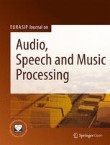Adaptive Long-Term Coding of LSF Parameters Trajectories for Large-Delay/Very- to Ultra-Low Bit-Rate Speech Coding
This paper presents a model-based method for coding the LSF parameters of LPC speech coders on a "long-term" basis, that is, beyond the usual 20–30 ms frame duration. The objective is to provide efficient LSF ...
